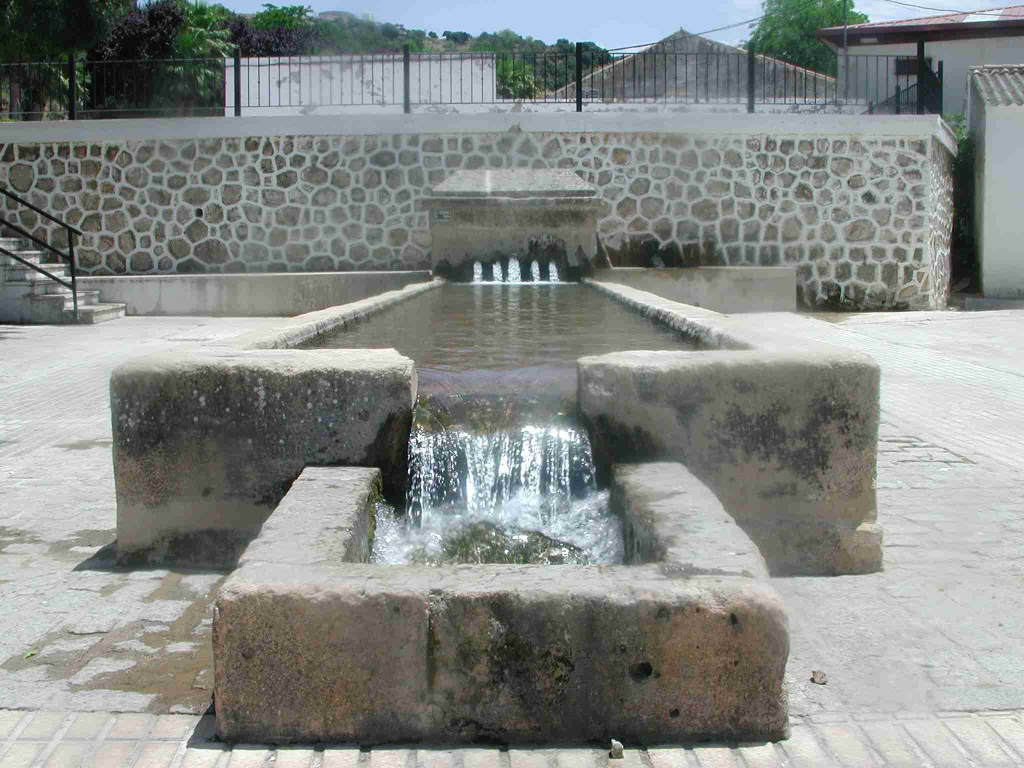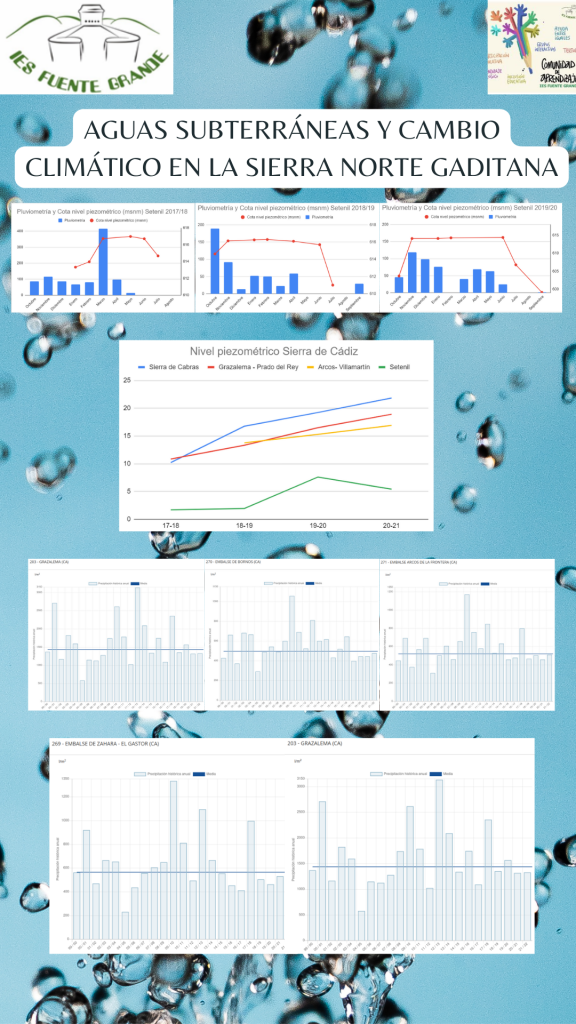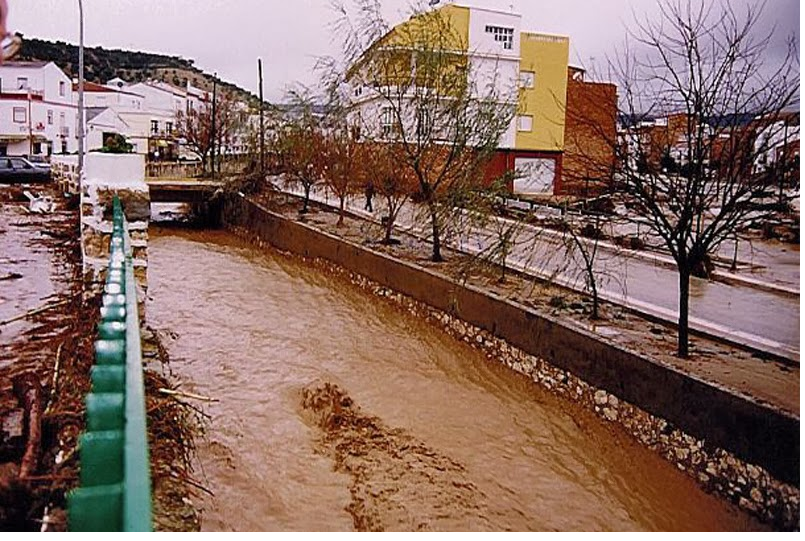Climate Detectives Projects 2022-2023
Project title: Groundwater and climate change in the northern Sierra of Cadiz.
Team: Team Sigma
VRWG+55 Alcalá del Valle Alcalá del Valle Spain 10 Student’s age: 16-17 years old
Does climate change affect the volume and availability of groundwater in the Sierra Norte de Cádiz, where our municipality is located?
¿Afecta el cambio climático al volumen y disponibilidad de agua subterránea en la Sierra norte de Cádiz donde se sitúa nuestro municipio?
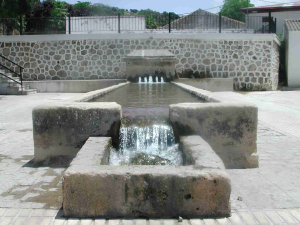
There is a decrease in the number of local wells and fountains supplied by groundwater. In particular, “La Fuente Grande”, one of the most important monuments of the municipality, was once a meeting point where an intense social life took place, especially for women who went to wash. Nowadays, water only comes out after heavy rains, only a few times a year.
In the first part of the research we identified the groundwater bodies near our locality. Then we studied the rocks to determine what type of aquifer they are. And finally, we have identified which of the different aquifers in the area supplies our town.
The second part of the research focused on the collection of data on rainfall in our town and in different areas of the Sierra de Cádiz, as well as the evolution of piezometric levels in the same areas. We contrasted both data to check if there was a correlation between the two magnitudes.
Initially we requested water consumption data from the company that manages the local water supply, but although they participated in an interview in a documentary that we recorded, they did not provide us with the official data in writing, so we did not include them in our research. This line of research was intended to rule out the hypothesis that the decrease in the volume of groundwater was due to an increase in water consumption by the local inhabitants.
Throughout our research we have conducted interviews with both local entities and neighbours who have told us their memories and impressions of the evolution of groundwater in the village. All these testimonies have been collected in a documentary that we hope to broadcast soon on local media and social networks.
Hay una disminución en los pozos y fuentes locales que se abastecen de aguas subterráneas. En concreto “La Fuente Grande”, uno de los monumentos más importantes del municipio y que antaño era un punto de encuentro donde se desarrollaba una intensa vida social, sobre todo para las mujeres que iban a lavar. En la actualidad solo sale agua tras lluvia intensas, en contadas ocasiones al año.
En la primera parte de la investigación hemos identificado las masas de agua subterránea cercanas a nuestra localidad. Después hemos estudiado las rocas para determinar de qué tipo de acuífero se tratan. Y por último hemos identificado de entre los distintos acuíferos de la zona, cual abastece a nuestra localidad.
La segunda parte de la investigación se ha centrado en la recopilación de datos sobre precipitaciones en nuestra localidad y en distintas zonas de la Sierra de Cádiz, así como la evolución de los niveles piezométricos en las mismas zonas. Hemos contrastado ambos datos para comprobar si había correlación entre las dos magnitudes.
Al principio solicitamos los datos de consumo de agua a la empresa que gestiona el abastecimiento de agua de la localidad pero aunque han participado en entrevista en un documental que hemos grabado, no nos han facilitado los datos oficiales por escrito, por lo que no los hemos incluido en nuestra investigación. Esta linea pretendía descartar la hipótesis de que la disminución en el volumen de agua subterránea se debiera a un aumento en el consumo de agua por parte de los habitantes de la localidad.
A lo largo de nuestra investigación hemos realizado entrevistas tanto a entidades locales como a vecinos que nos han contado sus recuerdos y sus impresiones sobre la evolución del agua subterránea en el pueblo. Todos estos testimonios los hemo recogido en un documental que esperamos emitir próximamente en los medio locales y redes sociales.
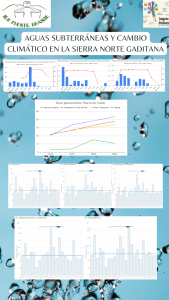
– Two hydrogeological units converge in our town: “Setenil-Ronda” (22,278 ha) – hydrographic district of the Guadalete-Barbate and “Sierra de Cañete” (10,599 ha) of the Guadalquivir.
– Alcalá del Valle is located between two outcrops of a different nature: one carbonate and the other detritic. The carbonate materials easily admit rainwater and surface runoff. The detritic materials have high permeability and porosity values, making them particularly suitable for the retention and circulation of groundwater.
– There is a decrease in the annual volume of precipitation in the last 4 hydrological years (18-19 to 21-22 and foreseeably 22-23) in the localities of the Sierra de Cádiz: Setenil, Grazalema, Zahara, Bornos, Arcos and Ubrique.
– If we compare the annual historical rainfall of these localities over 23 years, the last four years are not significantly remarkable, with even drier periods such as the hydrological year 04-05.
– There has been an increase in the piezometric level (depth) since hydrological year 17-18, which coincides with the decrease in annual rainfall in the Sierra de Cádiz.
– When comparing the precipitation curves by month and piezometric level (altitude), an increase in this level is observed, which is maintained for at least three months after the month with high to medium precipitation.
Conclusions and reflections:
– There is no significant decrease in precipitation (over the last 23 years), a longer time interval (at least 50 years) would have to be used to check the effect of climate change.
– There is a relationship between precipitation and the piezometric level with a one-month time lag. Aquifers retain water after rainfall for several months.
– The results lead us to new questions: Is there a change in the type of precipitation, with an increase in torrential rainfall? Does the problem of soil erosion in our area influence water infiltration?
– En nuestra localidad confluyen dos unidades hidrogeológicas: “Setenil-Ronda”(22.278 ha)-demarcación hidrográfica del Guadalete-Barbate y “Sierra de Cañete”(10.599 ha) del Guadalquivir.
– Alcalá del Valle se encuentra entre dos afloramientos de distinta naturaleza: uno carbonatado y otro detrítico. Los materiales carbonatados admiten con facilidad el agua de la lluvia y de las escorrentías superficiales. Los materiales detríticos, tienen valores altos de permeabilidad y porosidad, por lo que resultan especialmente adecuados para la retención y circulación del agua subterránea
– Hay una disminución en el volumen anual de precipitaciones en los últimos 4 años hidrológicos (18-19 hasta 21-22 y previsiblemente 22-23) en las localidades de la Sierra de Cádiz: Setenil, Grazalema, Zahara, Bornos, Arcos y Ubrique.
– Si comparamos las precipitaciones históricas anuales de estas localidades en 23 años, los últimos cuatro años no son destacables significativamente, con épocas aún más secas como el año hidrológico 04-05.
– Hay un aumento del nivel piezométrico (profundidad) desde el año hidrológico 17-18, que coincide con la disminución de la precipitaciones anuales en la Sierra de Cádiz.
– Al comparar las curvas de precipitaciones por meses y nivel piezométrico (altitud) se observa un aumento en esta cota que se mantiene al menos tres meses posteriores al mes con altas-medias precipitaciones.
Conclusiones y reflexiones:
– No se aprecian disminución significativa de las precipitaciones (en los últimos 23 años), habría que recurrir a un intervalo mayor de tiempo (al menos 50 años) para comprobar el efecto del cambio climático.
– Existe relación entre la precipitaciones y el nivel piezométrico con un mes de desfase. Los acuíferos retienen el agua tras las precipitaciones durante varios meses.
– Los resultado nos llevan a nuevas preguntas: ¿Hay un cambio en el tipo de precipitaciones, con aumento de las torrenciales? ¿Influye en la infiltración del agua el problema de erosión del suelo de nuestra zona?
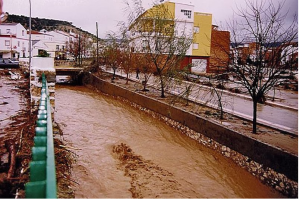
We summarise our reflections on human actions that can help to improve the problem of groundwater depletion in our area:
– All those actions aimed at curbing climate change. All these actions are classified into four main groups: food, packaging, energy and transport.
– Agriculture: Most of the population of our town is dedicated to agriculture, the intensive agricultural exploitation, especially of olive groves, has caused significant problems of erosion and flooding in the village. We are committed to a change towards sustainable agriculture, with a choice of species, rotations and respectful tillage techniques. It should be noted that irrigated farming is not particularly relevant in the area.
– Reduce water consumption.
Sintetizamos nuestras reflexiones sobre las acciones humanas que pueden ayudar a mejorar el problema de las disminución del agua subterránea en nuestra zona:
– Disminuir el consumo de agua: Con buenos hábitos domésticos, mejores instalaciones, electrodomésticos…
– Educación ambiental en los colegios e institutos para poner en valor el agua como recurso vital.
– Limitar la construcción y uso de piscinas privadas en detrimento de las públicas.
– Agricultura: La mayor parte de población de nuestra localidad se dedica a la agricultura, la explotación agrícola intensiva sobretodo de olivar ha originado importantes problemas de erosión e inundaciones en el pueblo. Apostamos por una cambio hacia la agricultura sostenible, con elección de especies, rotaciones y técnicas de labranza respetuosas con el medio ambiente. Cabe destacar que el cultivo de regadío no es especialmente relevante en la zona.
– Todas aquellas acciones encaminadas a frenar el cambio climático. Todas estas acciones las clasificamos en cuatro grandes grupos: Alimentación, envases, energía y transporte.
– Consumo responsable: ser conscientes de la huella hídrica asociada a nuestro consumo para reducirla en la medida de lo posible.
This project was automatically translated into English.
Projects are created by the teams and they take the full responsibility of the shared data.
← All projects

